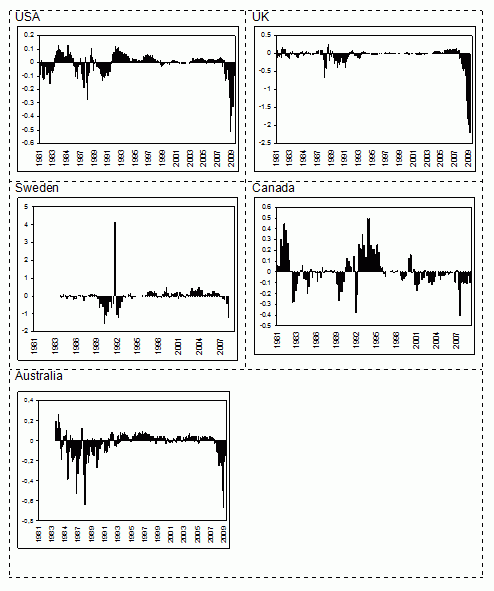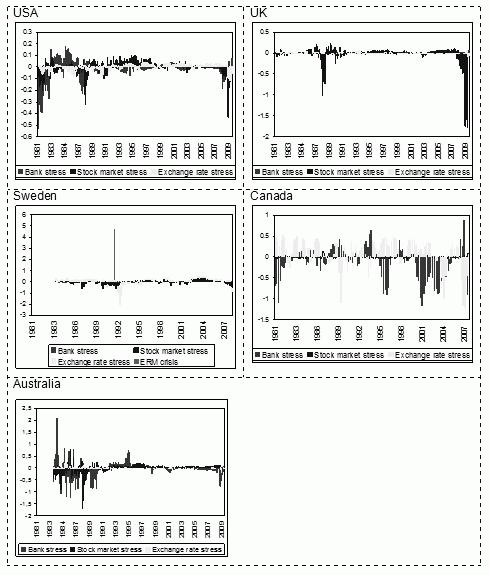The recent financial crisis has intensified interest in the nexus between monetary policy and financial stability. Official interest rates have been cut sharply to historical lows, and many unconventional measures have been used to pump liquidity into the international financial system. Central banks pursued monetary policy under high economic uncertainty coupled with large financial shocks in many countries. The financial crisis also raised new challenges for central bank policies, in particular those issues related to financial stability (Borio and Drehmann 2009). Although keeping the financial system stable is a major task, often delegated to central banks, how to consider financial stability concerns for monetary policy decision-making remains a puzzling question.
It may be reasonable to assume that monetary policy is likely to react to financial instability in a nonlinear way (Goodhart et al 2009). When a financial system is stable, the interest-rate setting process largely reflects macroeconomic conditions, and financial stability considerations enter monetary-policy discussions only to a limited degree. On the other hand, central banks may alter their monetary policies to reduce financial imbalances if these become severe.
Our recent research (Baxa et al forthcoming) examines the reactions in the five main central banks (the US Fed, the Bank of England, the Reserve Bank of Australia, the Bank of Canada, and Sveriges Riksbank) during periods of financial stress over the last three decades. In particular, we estimate the time-varying monetary policy rule of each bank to assess whether and how its policy rate was adjusted in the face of financial instability. We track financial stress by means of a continuous financial-stress indicator developed recently by the IMF (see Cardarelli et al 2011) as well as its main subcomponents (namely, banking stress, stock-market stress, and exchange-rate stress). Our empirical framework is therefore suitable for detecting the periods and types of stress that were perceived as the most worrying and for quantifying the intensity of the policy response.
Although theoretical studies disagree about the viability of considering financial instability for interest-rate setting (eg Cecchetti and Li 2008, Cúrdia and Woodford 2010, Teranishi 2009), our empirical results suggest that central banks often alter the course of monetary policy in the face of high financial stress, mainly by decreasing their policy rates (see Figure 1). Yet the size of this response varies substantially over time and across countries as well as in terms of specific types of financial stress. The recent financial crisis evoked the most generalised response and interest rates decreased in the range of 50 to 200 basis points owing solely to financial instability concerns (above what could be attributed to the decline in inflation expectations and output below its potential). However, significant interest-rate adjustment to financial instability has been found for all central banks over the whole sample period. In terms of the specific components of stress, most banks seemed to respond to stock-market stress and bank stress, while exchange-rate stress drove central bank reactions only in more open economies (see Figure 2). The comparison of the two Figures demonstrates the challenge of tracking financial stress by overall versus partial measures.
- First, the stress effects related to individual subcomponents do not necessarily sum up to the stress effect related to the entire index.
- Second, it should be noted that a positive response to one stress subcomponent may cancel out in the face of a negative response to another one, making the response to the overall stress negligible.
Figure 1. The effect of financial stress on interest-rate setting
Notes: The Figure depicts the evolution of the financial-stress effect. The stress effect (y-axis) is defined as the product of the estimated time-varying coefficient on the financial-stress indicator in the monetary-policy rule and the value of the IMF financial-stress indicator. The stress effect shows the magnitude of the interest-rate reaction to financial stress in percentage points.
Figure 2. The effect of financial-stress components on interest-rate setting: Bank stress, exchange-rate stress, and stock-market stress
Notes: The Figure depicts the evolution of the components of the financial-stress effect, namely, the bank-stress effect, the exchange-rate stress effect, and the stock-market stress effect. The stress effect (y-axis) is defined as the product of the estimated coefficient on the given component of the financial-stress indicator in the monetary-policy rule and the value of the corresponding component of the IMF financial-stress indicator. The stress effect shows the magnitude of the interest-rate reaction to financial stress in percentage points.
The results also point to the usefulness of improving the standard version of the monetary-policy rule by some measure of the financial conditions to get a better understanding of the interest-rate setting process, especially when financial markets are not stable.
On the normative side, the results relate to the current debate on the appropriate target of central banks, in particular, whether financial stability should be explicitly included as an objective of monetary policy. Our results suggest that this would be a sensible and transparent solution given that central banks reacted to financial stress in the past regardless their formal mandate. Although we cannot evaluate the efficiency of such policy given the impossibility of running a counterfactual experiment of no reaction, the important lesson learned is that pursuing both objectives might not be in practice inconsistent. Many periods of financial stress, especially banking-related, were followed by economic downturns (Cardarelli et al 2011), which in turn muted future inflation pressures. Therefore, financial stability should be understood as one key element of overall economic stability as well as the long-term price stability.
References
Baxa, J, R Horváth and B Vašíček (forthcoming), “Time-Varying Monetary-Policy Rules and Financial Stress: Does Financial Instability Matter for Monetary Policy?”, Journal of Financial Stability.
Borio, C and M Drehmann (2009), “Towards an Operational Framework for Financial Stability: ‘Fuzzy’ Measurement and Its Consequences”, BIS Working Paper No. 284.
Cardarelli, R, S Elekdag and S Lall (2011), “Financial Stress and Economic Contractions”, Journal of Financial Stability, 7(2):78-97.
Cecchetti, S and L Li (2008), “Do Capital Adequacy Requirements Matter for Monetary Policy”, Economic Inquiry, 46(4):643-659
Cúrdia, V and M Woodford (2010), “Credit Spreads and Monetary Policy”, Journal of Money, Credit and Banking, 42(s1), 3-35.
Goodhart, C, C Osorio and D Tsomocos (2009), “An Analysis of Monetary Policy and Financial Stability: A New Paradigm”, CESifo Working Paper No. 2885.
Teranishi, Y (2009): “Credit Spread and Monetary Policy”, IMES Discussion Paper Series 2009-E-14, Bank of Japan.







